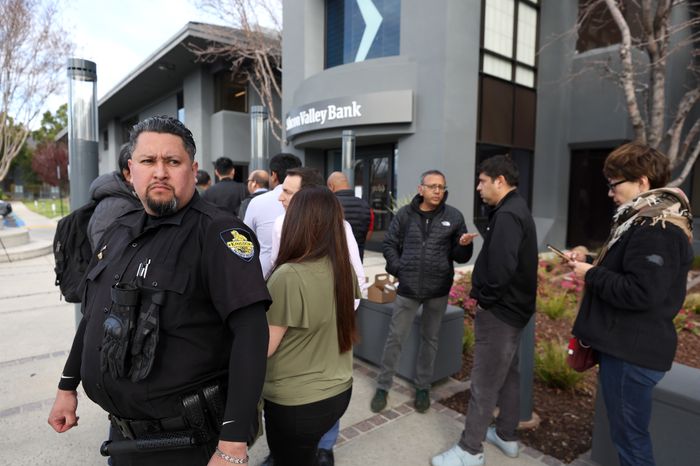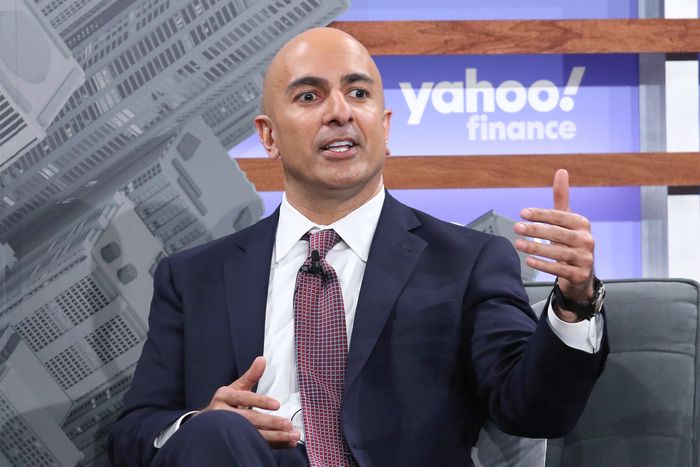Federal Reserve Chair Jerome Powell finds himself in a place no central banker wants to be: working to avert a credit crunch, which calls for looser monetary policy, while fighting high inflation, which demands the opposite.
Strains in the banking industry, which followed the collapse of three midsize lenders this spring, help explain why some central bank officials are leaning toward holding interest rates steady at their meeting this week—even though the economy and inflation haven’t slowed as much as they expected.
Fed officials don’t think a crisis is imminent, attributing recent troubles to idiosyncrasies at the three banks. But current and former central bankers say if stresses worsen, the Fed will face a more difficult trade off. Powell and his colleagues would have to choose between focusing on failing banks or high inflation.
“They’re between a rock and a hard place. It’s a very, very tough situation,” said Raghuram Rajan, a former governor of the Reserve Bank of India. “You’re damned if you raise rates significantly more and put even more pressure on the banks, but you’re damned if you don’t” and inflation accelerates.
One risk is timing: if inflation becomes entrenched in public psychology, becoming self-perpetuating, that could force the Fed to hold short-term interest rates higher for longer.
“If inflation is going to fall quickly…we might be in a position to be able to cut rates, if not this year, then soon in the new year,” said Minneapolis Fed President Neel Kashkari in an interview last month. “But if, on the other hand, inflation is much more persistent and much more entrenched…then I think the stresses in the banking sector probably become more serious.”
The economic expansion, the Fed’s credibility and Powell’s legacy are at stake. Powell was appointed to a second term as Fed chair in part because of his popularity in Congress, with his initial response to the Covid shock in 2020 and his handling of President Trump’s attacks earning accolades on both sides of the aisle.
The past two years have been much rockier. First, the Fed misjudged inflation. More recently, the Fed’s performance on bank regulation has come under fire.
Separation principle
During the pandemic, the Fed signaled plans to hold interest rates at very low levels for years and purchased trillions of bonds to spur additional borrowing, and the government poured additional stimulus into the economy. The moves pumped banks full of deposits in 2021.
As inflation hit 9% last year, Powell accelerated interest-rate increases because he and his colleagues wanted to stop an inflationary mind-set from taking root.
By February, the Fed had increased rates by 4.5 percentage points in one year—more swiftly than any time in the past 40 years.
Bank supervisors didn’t quickly spot how those rising rates had created a dangerous mismatch between some banks’ assets—securities and loans paying low rates—and liabilities—deposits and other borrowing with higher rates.
That triggered a run on Silicon Valley Bank in March.
The Fed and other regulators responded by backstopping the uninsured deposits of SVB and another bank that faced a run, New York-based Signature Bank, on March 12. They also agreed to lend to banks in general on favorable terms, putting money back into the economy.
But with inflation still too high, the Fed’s rate-setting Federal Open Market Committee lifted rates on March 22. They raised them again in early May, to the current range between 5% and 5.25%, just days after regulators arranged a shotgun sale of a third lender, First Republic Bank, to JPMorgan Chase.

In making these moves, the central bankers were operating under their so-called separation principle: They use emergency lending and other regulatory tools to address financial instability so they can use monetary policy, primarily interest rates, to combat inflation.
While emergency lending tools prevented other bank runs, they may not have fixed the underlying problem for some regional and midsize banks, whose long-term viability is threatened if higher rates force them to pay significantly more for deposits.
Banks are facing losses on fixed-rate securities they acquired when rates were very low in 2021, though they don’t have to recognize losses if the investments are held to maturity. The Federal Deposit Insurance Corp. recently estimated such unrealized losses were around $515 billion at the end of March. That number would jump to well above $1 trillion if it included losses on low-yielding mortgages and other loans made when rates were much lower.
Banks’ emergency borrowing from the Fed remains high, and an index of regional bank stocks is down 19% this year, though it has rebounded from a decline of 29% in early May. Surveys show banks continue to tighten lending standards as their funding costs rise and as they face the prospect of tougher supervision and regulation.
A credit crunch could initially help the Fed by slowing the economy and easing price pressures, but the slowdown in credit growth could easily get out of control. Raising interest rates in such a scenario could be like smacking a ketchup bottle repeatedly—nothing comes out at first, and then the whole bottle suddenly empties all over your dinner.
The conventional wisdom holds that rising interest rates are good for banks. While the value of their loans and securities declines, when rates rise, their deposits also become more valuable because banks don’t fully pass along higher rates to depositors.
This assumes that depositors are unlikely to move their money in search of a higher yield—such as to another bank or a money-market mutual fund. If depositors are mobile, “then higher rates in general start to be pretty bad for banks,” said former Fed governor Jeremy Stein.
The run on SVB risked waking up sleepy depositors to the possibility of earning more on their money by moving it elsewhere. Several banks have been advertising high-yield savings accounts with rates between 4% and 5%, well above the national average yield of 0.25% for traditional savings accounts, according to Bankrate.com.
“The worry is that the events of the past few months are for banks what the pandemic was for Zoom use, once people were forced to figure it out,” said Stein.
Fed regulators are keeping close tabs on 20 to 30 institutions they see as more vulnerable following this spring’s banking turmoil.
Analysts worry more shoes could drop as the economy slows and defaults rise. Loans on office buildings, whose values have tumbled as remote work reduces demand for those properties, are seen as particularly vulnerable.
Banks lost deposits after the failureof Silicon Valley BankChange in deposits since January 2021*Source: Federal ReserveNote: Figures are seasonally adjusted and excludecertificates of deposit of more than $100,000. Largebanks are the top 25 institutions.
Even if banking problems appear to have settled down, “you’re still going to have failures,” said former Dallas Fed President Robert Kaplan. “You’re still going to need to merge a number of them.”
Any lending downturn could hit small businesses harder than large ones, which rely less on bank loans. Banks with less than $250 billion in assets are responsible for 70% of all lending to firms with fewer than 100 employees.
Kashkari said he wasn’t seeing evidence of a credit contraction in his Fed district, which includes much of the Upper Midwest. But his experience as a senior Treasury Department official during the 2008 financial crisis makes him recognize “these banking stresses are not necessarily completely behind us,” he said.
‘Hanging onto the cliff with their fingernails’
While strong inflation, job growth and consumer spending this spring might normally prompt Fed officials to increase rates at their meeting Tuesday and Wednesday, a possible lending pullback from banking strains offers a reason to hold off—a sign the separation principle has limits.

“Our tools can have separate objectives, but their effects are often not entirely independent…because financial and macroeconomic stability are so deeply intertwined,” Powell said on May 19.
While higher interest rates have been the immediate cause of banks’ losses, lowering short-term rates to reduce pressure on banks would backfire, said Randal Quarles, who was the Fed’s vice chair for bank supervision from 2017 to 2021.
That is because if inflation doesn’t fall, investors could demand higher yields on medium- and long-term debt to compensate for the risk that inflation erodes their purchasing power. This would be especially harmful for banks, which finance themselves with medium-term debt. “If you haven’t contained inflation, you will have the savings and loan problem all over again,” said Quarles, referring to the failures of hundreds of financial institutions in the 1980s and 1990s.
Fed officials have suggested that even if they forgo an increase this week, they could nudge rates higher at later meetings. That would give them more time to assess whether economic activity and banking sector conditions are unfolding as they expect.
“No model is going to say increasing interest rates in June rather than September is going to make a huge difference to the path of inflation, but if you raise interest rates and you already have a lot of embedded problems in the bank portfolio, you may end up causing a more severe recession,” said Eric Rosengren, who was president of the Boston Fed from 2007 to 2021.
Fed officials are split over whether to raise rates this week. Some worry the economy isn’t slowing down enough and aren’t as concerned about the banking problems. Steady income growth could provide the fuel that allows consumers and businesses to tolerate higher prices and continue spending.
Cleveland Fed President Loretta Mester in an interview last month said she doesn’t see a compelling reason to hold rates steady until the next move is equally as likely to be up as down. The Fed hasn’t reached that point yet, she said.
Failing to get a handle on inflation now means "we're going to have to do a lot more later on, just like Paul Volcker did in the late '70s and early '80s," said St. Louis Fed President James Bullard at a conference last month. "That's why I'd like to err on the side of doing a little more here."
Bullard also cautioned against extrapolating SVB's problems to the entire industry because of its high concentration of uninsured deposits that funded a big portfolio of fixed-rate securities.
Others are worried more about raising rates too far and being forced to make a confusing U-turn to cutting rates if the banking crisis worsens.
Chicago Fed President Austan Goolsbee said last month's decision to raise rates was a close call because of uncertainty over how much the banking turmoil would curb lending.
"We still fundamentally have to figure out the question of 'Is this as big of a credit stress event as, say, the S&L problems in the late '80s and early '90s? Is this a temporary thing that is just a rebalancing of deposits from threatened institutions?'" he said in an interview last month.
Some former Fed officials who regret not raising rates sooner say the central bank should be more patient now. "The Fed's policy is plenty tight. These things just take longer" to run their course, said Quarles. "Over the course of the summer, you're going to have a revaluation of assets as people realize, 'Oh my gosh, higher rates are going on longer than I thought.'"
Quarles, who is chairman of a private-equity firm, said he anticipates that will cause more distress for banks, insurers and other financial institutions "that have been hanging onto the cliff with their fingernails, thinking that interest rates are going to start coming down."
